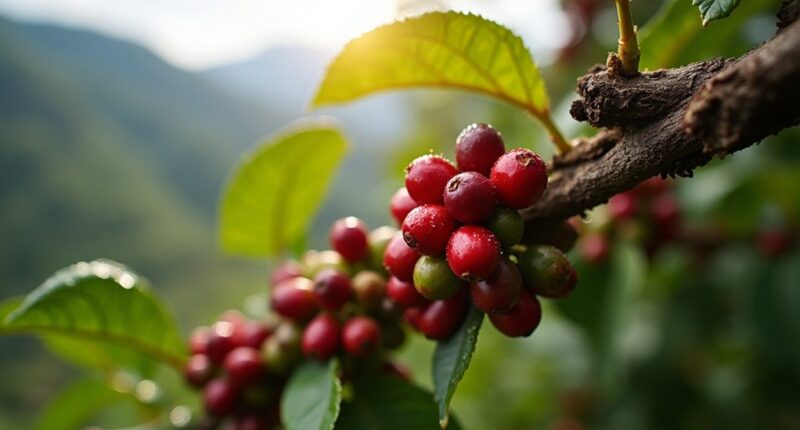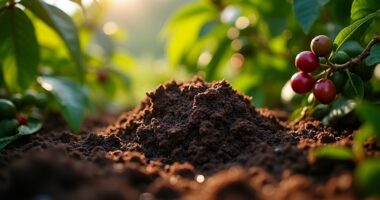You can thank several exciting places for your coffee fix! It all starts in coffee-growing regions like Brazil, Vietnam, and Colombia. Brazil’s the big deal, pumping out tons of beans, while Vietnam’s got a serious thing for Robusta. And let’s not forget about Colombia, known for fancy Arabica coffee. Each region pours its heart into those beans, creating unique flavors. Curious about how it’s all grown and what else is brewing? Stick around for more juicy details!
At a Glance
- Coffee is primarily sourced from major producing regions like Brazil, Vietnam, Colombia, Indonesia, and Ethiopia.
- Brazil produces about 37% of the world’s coffee, mainly Arabica and Conilon beans.
- Vietnam specializes in Robusta coffee, accounting for 96% of its production.
- Colombia is famous for its high-quality Arabica coffee beans, known for their rich flavor.
- Ethiopia, the birthplace of coffee, offers unique floral notes and diverse coffee profiles.
The Origins of Coffee
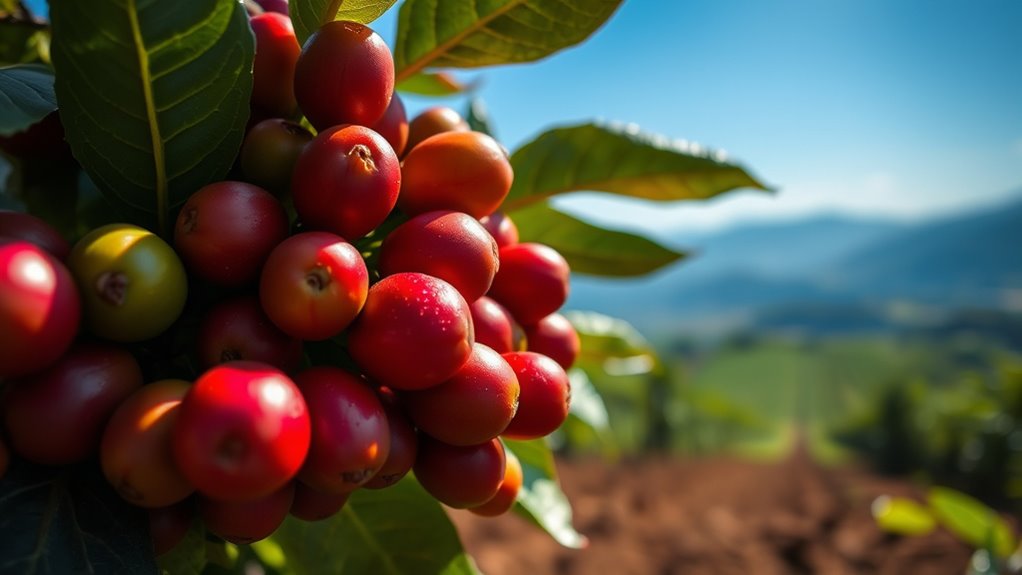
When you think about coffee, you probably don’t imagine a goat herder in Ethiopia discovering its magic, right?
Well, that’s exactly what Ethiopian legends say happened with Kaldi, who noticed his goats bouncing off the walls after munching on coffee berries.
Ethiopian legends tell of Kaldi, who discovered the energizing effects of coffee when he saw his goats bouncing with joy.
Fast forward to Yemen, where Sufi rituals transformed coffee into a nighttime drink for monks needing a boost during prayers.
This incredible journey from the Ethiopian highlands to the bustling cafes of today shows how coffee connects us all. Additionally, the distinct rich flavors of Kenyan coffee illustrate the diverse profiles that arise from different regions of coffee cultivation.
Major Coffee Producing Regions
Coffee’s journey doesn’t just stop at its legendary beginnings; it continues through some pretty remarkable regions around the world.
Picture Vietnam, where robust Robusta beans thrive in the Central Highlands, and Colombia, famous for its premium Arabica coffee beans with flavors that dance on your palate.
Then there’s Indonesia, with its diverse islands offering unique coffee profiles, and Ethiopia, the birthplace of coffee, bursting with floral notes.
Uganda joins the mix, providing bold Robusta and up-and-coming Arabica.
Each coffee region showcases production diversity, giving us that perfect cup we all crave.
Brazil: The Coffee Powerhouse
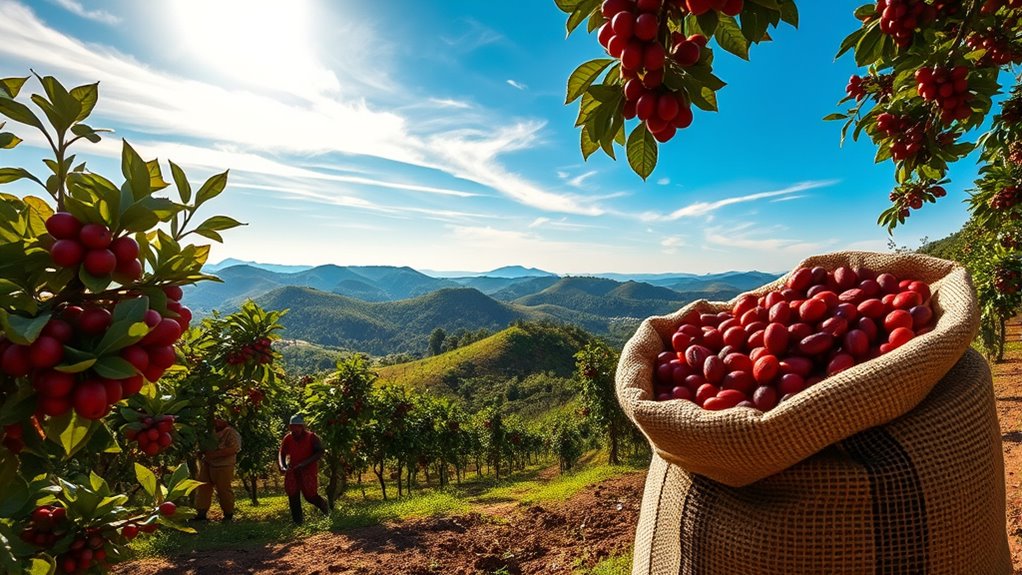
Brazil isn’t just a pretty face in the coffee world; it’s the powerhouse that fuels our caffeine cravings! With about 37% of global coffee production, Brazilian Coffee is the real deal. In addition to Brazil, Kenyan coffee is celebrated for its unique flavors and high quality, making it a noteworthy contender on the global stage. Check out this quick table for a snapshot:
| Year | Arabica Production | Conilon Production |
|---|---|---|
| 2024/25 | 37 million bags | 18.7 million bags |
| 2025 | Low yield forecast | High yield forecast |
| Exports | $1.369 billion | 18.5% drop |
| Destinations | U.S., Germany, Italy | – |
Vietnam: The Robusta Leader
If you thought Brazil was the only player in the coffee game, think again! Vietnam’s taking the spotlight with its Robusta dominance, producing a whopping 96% of its coffee that’s loved worldwide.
With 31 million bags expected by 2025, those cultivation practices in the Central Highlands are paying off big time. As global demand soars, Vietnamese coffee exports hit $5.62 billion, bringing a smile to farmers’ faces.
Plus, the rise in domestic consumption means you’ll find more tasty brews at home. With new processing facilities popping up, Vietnamese coffee is embracing market trends like a pro. Cheers to that! Additionally, the unique rich flavors of ground coffee from Vietnam’s Robusta beans are making their mark on coffee enthusiasts globally.
Colombia: Home of Arabica
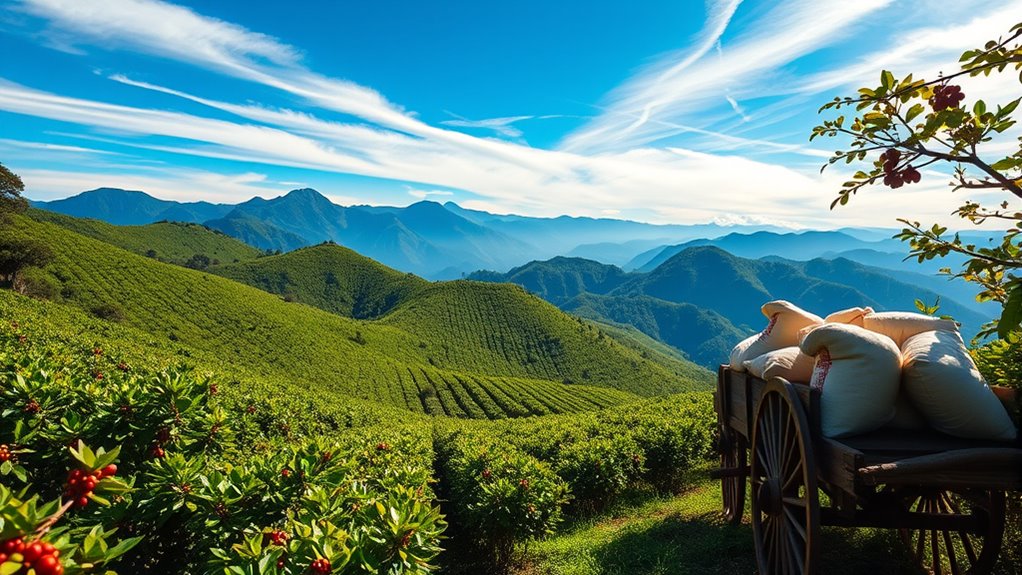
Imagine waking up to the rich aroma of freshly brewed coffee, and you’re sipping on a cup that hails from Colombia, the proud home of Arabica beans. Colombian coffee isn’t just delicious; it’s crafted by dedicated Colombian farmers who pour their hearts into every bean. They produce around 12.4 million bags annually, and here’s what makes it special:
| Aspect | Details |
|---|---|
| Production | 100% Arabica |
| Quality | Mild and high-quality |
| Farmers | 60% from small farms |
In Colombia, the emphasis on high-quality coffee beans ensures that each cup delivers a unique flavor profile that enthusiasts cherish.
Other Key Coffee Producers
When you think about coffee, you might picture Colombia or Brazil, but hold on—there are plenty of other countries brewing up some serious java!
Vietnam’s rocking the Robusta scene, making instant coffee a staple with its bold flavor profiles.
Vietnam is making waves in the coffee world with its bold Robusta, turning instant coffee into a beloved staple.
Then there’s Indonesia, where diverse coffee varieties shine, thanks to their unique wet hulling process.
Ethiopia? That’s the birthplace of Arabica, offering coffees with floral and fruity notes that’ll tickle your taste buds.
And don’t forget Honduras and Uganda, where high-altitude Arabica and rare Robusta beans are crafted with love. Additionally, you can discover the finest coffee beans at Walmart, which offers a variety of options from these renowned coffee-producing countries.
Coffee Cultivation and Production
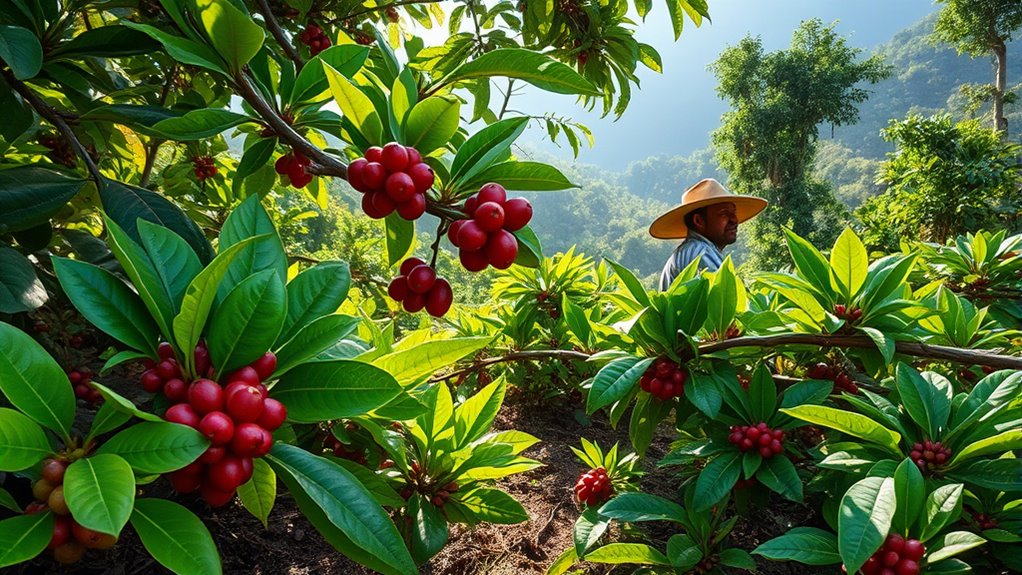
Coffee cultivation and production is a fascinating journey that starts with selecting the right seeds, and trust me, it’s not as simple as picking a random bag at the store! You’ll nurture those seeds with care, ensuring they thrive in shaded beds, perfect for coffee seedling care. It takes about three to four years for your plants to start producing cherries, so patience is key. Plus, sustainable practices help protect our planet. Here’s a quick look at some essentials:
| Step | Description | Importance |
|---|---|---|
| Seed Selection | Choose high-quality seeds | Better flavor |
| Soil Management | Nutrient-rich and well-drained | Healthy plants |
| Watering | Consistent moisture | Promotes growth |
| Pest Control | Integrated methods | Protects crops |
| Shading | Moderates temperature | Improves bean quality |
Additionally, the quality of water used for irrigation plays a significant role in the overall flavor profile of the coffee beans produced.
Harvesting and Processing Techniques
Harvesting and processing coffee is like preparing a gourmet meal; it’s all about the right techniques that turn those little cherries into the delicious brew you love.
You’ve got harvesting methods like selective picking, where only the ripest cherries are chosen, or strip picking, which is a bit like a cherry buffet!
Then, there are processing techniques. Wet processing gives you a clean, citrusy flavor, while dry processing offers a smooth, heavy-bodied cup. Additionally, the choice of Keurig coffee pods can enhance your coffee experience, connecting you to the coffee’s journey.
Processing techniques play a vital role; wet processing delivers a bright, citrusy profile, while dry processing yields a rich, full-bodied experience.
Each method shapes the taste, connecting you to the coffee’s journey.
Market Dynamics and Trade Trends
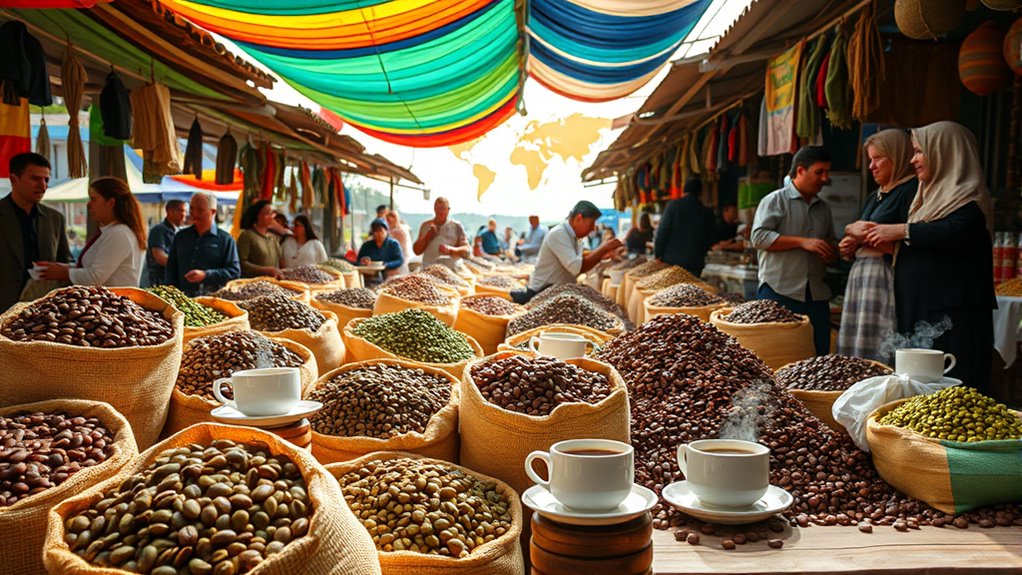
As you sip your morning brew, have you ever wondered what makes the coffee market tick? The coffee world is buzzing with excitement, but it’s also a bit unpredictable. Here’s what’s happening:
- Prices have shot up by about 90% recently!
- Trade tariffs are throwing a wrench in Brazil’s exports to the U.S.
- Emerging markets are driving demand like never before.
Market volatility’s keeping everyone on their toes, and it’s fascinating to see how factors like weather and tariffs affect what’s in your cup. Additionally, the growing popularity of low acid organic coffees is influencing consumer preferences and reshaping market trends.
Challenges Facing Coffee Production
When you think about it, producing that perfect cup of coffee isn’t all sunshine and rainbows. Coffee faces some serious challenges!
Climate change shrinks suitable land, and surprising weather makes pests thrive like they own the place. Plus, water’s a big deal—coffee needs it, but using too much strains local resources.
Deforestation? Yep, that’s happening too.
Additionally, sustainable practices like embracing agroforestry and better farming techniques can help us tackle these issues together.
But here’s the silver lining: sustainability practices can help! By embracing agroforestry and better farming techniques, we can tackle these issues together.
